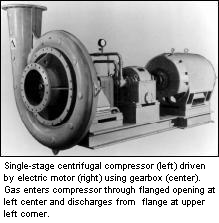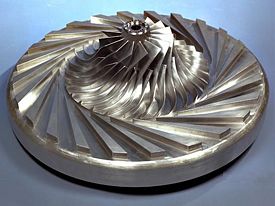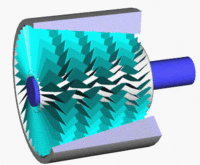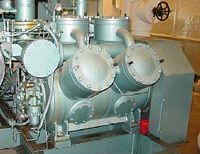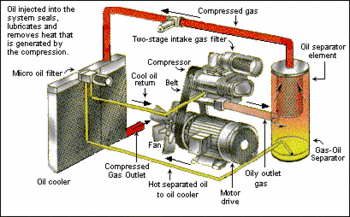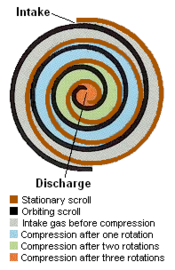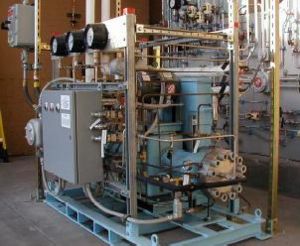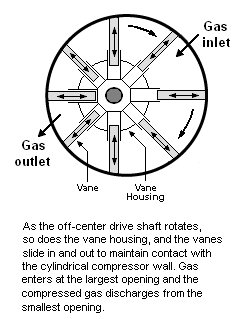Gas compressor
A gas compressor is a machine that increases the pressure of a gas by reducing its volume.
Compressors are used to raise the pressure of gases because gases are compressible fluids. Pumps are used to raise the pressure of liquids because liquids are practically incompressible. Compressors and pumps are similar in that both increase the pressure of a fluid and both can transport the fluid through piping.[1][2]
Types of compressors
There are primarily two basic types of compressors. One type uses dynamic compression accomplished by the mechanical action of rotating contoured blades which impart velocity and hence pressure to the flowing gases. The other type uses positive displacement accomplished by trapping a volume of gas and displacing it by the action of a piston or a rotating member.
The dynamic compression compressors are sub-categorized as either centrifugal compressors where the gas flows radially through the compressor or as axial compressors where the gas flows straight through the compressor (parallel to the rotating drive shaft of the compressor).
The positive displacement compressors are sub-categorized as either reciprocating compressors or rotary compressors and each of those include a number of different types.
The main types of gas compressors are illustrated in the chart below and each type is then discussed in the following sections:
Centrifugal compressors
Centrifugal compressors use a rotating disk or impeller in a shaped housing to force the gas to the rim of the impeller, increasing the velocity of the gas. A diffuser (divergent duct) section converts the velocity energy to pressure energy.
Figure 3 is a photograph is of a typical single-stage centrifugal compressor driven by an electrical motor and Figure 2 is a photograph of a centrifugal compressor impeller and diffuser.
They are very widely used for continuous, stationary service in industries such as petroleum refineries, chemical and petrochemical plants, natural gas processing plants and many other industrial facilities.[3][4][5]
Their applications can range from 100 hp (75 kW) to thousands of horsepower. With multiple staging,
centrifugal compressors can achieve extremely high output pressures greater than 10,000 psi (69 MPa).
The compression ratio (i.e., the gas discharge pressure divided by the gas inlet suction pressure) of a centrifugal compressor is typically limited to about 3.5 to 1. To achieve higher compression ratios, a series of compressors (referred to as compression stages) are required.
Since compression generates heat, the compressed gas has to be cooled between stages. The inter-stage coolers may result in some partial condensation of the gas and the condensed liquid is removed in vapor-liquid separators.
Many large snow-making operations (like ski resorts) use this type of compressor. They are also used in internal combustion engines (as superchargers and turbochargers), in small gas turbine engines and as the final compression stage of medium sized gas turbines.
Axial-flow compressors
Axial-flow compressors are dynamic rotating compressors that use arrays of fan-like airfoils to progressively compress the working fluid. They are used where there is a requirement for a high flows or a compact design.
The arrays of airfoils are set in rows, usually as pairs: one rotating and one stationary. The rotating airfoils, also known as blades or rotors, accelerate the fluid. The stationary airfoils, also known as a stators or vanes, turn and decelerate the fluid; preparing and redirecting the flow for the rotor blades of the next stage.[3] Axial compressors are almost always multi-staged, with the cross-sectional area of the gas passage diminishing along the compressor to maintain an optimum axial Mach number. Beyond about 5 stages or a 4:1 design pressure ratio, variable geometry is normally used to improve operation.
Axial compressors can have high efficiencies; around 90% polytropic at their design conditions. However, they are relatively expensive, requiring a large number of components, tight tolerances and high quality materials. Axial-flow compressors can be found in medium to large gas turbine engines, in natural gas pumping stations, and within certain chemical plants.
Reciprocating compressors
Reciprocating compressors use pistons driven by a crankshaft. They can be either stationary or portable, can be single or multi-staged, and can be driven by electric motors or internal combustion engines.[3][6] [7] Small reciprocating compressors from 5 to 30 horsepower (hp) are commonly seen in automotive applications and are typically for intermittent duty. Larger reciprocating compressors well over 1000 hp are still commonly found in large industrial and petroleum applications. Discharge pressures can range from low pressure to very high pressure (>5000 psi or 35 MPa). In certain applications, such as air compression, multi-stage double-acting compressors are said to be the most efficient compressors available, and are typically larger, noisier, and more costly than comparable rotary units.[8]
Rotary screw compressors
Rotary screw compressors use two meshed rotating positive-displacement helical screws to force the gas into a smaller space.[3][9][10]
There are two types of screw-compressors, those that utilize a circulating oil to seal and cool the screws and those that operate completely dry (i.e., oil-free).
Figure 6 is a diagram of a complete screw compression system utilizing a circulating oil. Such systems are referred to as oil-bath screw compressors.
Figure 7 is a photo of the two screws within the body of a screw compressor: a female and a male screw. The female screw has inlets and the male screw has convex helical inlets. The screws rotate in opposite directions with the female screw receiving the driving power and transmitting this power to the male screw through a set of synchronization gears.
As the screws rotate, the gas is drawn into the inlet port and fills up the space between the screws. The compression begins when the end of a male thread blocks the end of a female thread. The volume available between the compressor body and these two threads then progressively decreased during rotation. When this volume merges into the delivery outlet of the compressor, compressed gas is discharged from the compressor.
Screw compressors are typically used for continuous operation in commercial and industrial applications and may be either stationary or portable. Their applications range from 3 hp (2.24 kW) to over 500 hp (375 kW) and from low pressure to very high pressure (>1200 psi or 8.3 MPa).
Scroll compressors
A scroll compressor (also known as a scroll vacuum pump) uses two interleaved spiral-like vanes to compress gases. The vane geometry may be involute, archimedean spiral, or hybrid curves.[11][12][13] The scroll compressor concept was first developed in the early 1900s.
A scroll is an involute spiral which, when matched with a mating spiral scroll form as shown in Figure 9, generates a series of crescent-shaped gas pockets between the two scroll elements.
Scroll compressors work by moving one spiral element inside another stationary spiral to create a series of gas pockets that become smaller and increase the pressure of the gas. The largest openings are at the outside of the scroll where the gas enters. As these gas pockets are closed off by the moving spiral, the pockets move towards the center of the spirals and become smaller and smaller. This increases the pressure of the gas until it reaches the center of the spiral and is discharged through a port near the center of the scroll. The entire process is continuous.
The moving scroll orbits in an eccentric path within the stationary (fixed) scroll as it creates the series of gas pockets. During compression, several pockets are being compressed simultaneously, resulting in a very smooth process. Maintaining an even number of gas pockets on opposite sides reduces any vibration inside the compressor.
The two scrolls (one colored blue and the other colored pink) can be seen in the right center of the photo in Figure 9.
Scroll compressors are very widely used, for example, in air conditioning systems. They operate more smoothly, quietly, and reliably than other types of compressors in the lower volume range.
Diaphragm compressors
A diaphragm compressor (also known as a membrane compressor) is a variant of the conventional reciprocating compressor. The compression of gas occurs by the movement of a flexible membrane, instead of an intake element. The back and forth movement of the membrane is driven by a rod and a crankshaft mechanism. Only the membrane and the compressor box come in touch with the gas being compressed.[3]
Diaphragm compressors are used for hydrogen and compressed natural gas (CNG) as well as in a number of other applications.
The photograph included in this section (Figure 8) depicts a three-stage diaphragm compressor used to compress hydrogen gas to 6,000 psi (41 MPa) for use in a prototype compressed hydrogen and compressed natural gas (CNG) fueling station built in downtown Phoenix, Arizona by the Arizona Public Service company (an electric utilities company). Reciprocating compressors were used to compress the natural gas.
The prototype alternative fueling station was built in compliance with all of the prevailing safety, environmental and building codes in Phoenix to demonstrate that such fueling stations could be built in urban areas.
Rotary vane compressors
- See also: Rotary vane pump
Rotary vane compressors consist of an off-center drive shaft that rotates a housing for a number of vanes. As the off-center housing rotates, the vanes slide in and out of their housing slots to keep contact with the outer wall of the compressor.[3] Thus, a series of decreasing volumes is created by the rotating vanes. Rotary vane compressors are, with piston compressors, one of the oldest of compressor technologies.
With suitable port connections, the rotary vane devices may be either a compressor or a vacuum pump. They can be either stationary or portable, single or multi-staged, and driven by electric motors or internal combustion engines. Dry vane machines are used at relatively low pressures (e.g., 200 kPa) for bulk material movement whilst oil-injected machines have the necessary volumetric efficiency to achieve pressures up to about 1.30 MPa in a single stage. A rotary vane compressor is well suited to electric motor drive and is significantly quieter in operation than the equivalent piston compressor.
Compressor drivers
There are many types of equipment, often referred to as prime movers, which can be used to drive a compressor:
- Steam turbines and gas turbines
- Natural gas engines, gasoline engines and diesel engines
- Electric motors
- Hydraulic power systems
Applications
Gas compressors are used in various applications where either higher gas pressures or lower volumes of gas are needed:
- In pipeline transport of purified natural gas to move the gas from the production site to the consumer.
- In petroleum refineries, natural gas processing plants, petrochemical and chemical plants, and similar large industrial plants for compressing intermediate and end product gases.
- In refrigeration and air conditioning systems (see Vapor-compression refrigeration).
- In gas turbine systems to compress the intake combustion air
- In storing purified or manufactured gases in small volume, high pressure cylinders for medical, welding and other uses.
- In many various industrial, manufacturing and building processes to power all types of pneumatic tools.
- In pressurized aircraft to provide a breathable atmosphere of higher than ambient pressure.
- In some types of jet engines (such as turbojets and turbofans) to provide the air required for combustion of the engine fuel. The power to drive the combustion air compressor comes from the jet's own turbines.
- In SCUBA diving, hyperbaric oxygen therapy and other life support devices to store breathing gas in a small volume such as in diving cylinders.
- In submarines, to store air for later use in displacing water from buoyancy chambers, for adjustment of depth.
- In turbochargers and superchargers to increase the performance of internal combustion engines by increasing mass flow.
- In rail and heavy road transport to provide compressed air for operation of rail vehicle brakes or road vehicle brakes.
References
- ↑ Pierre Trambouze (2000). Petroleum Refining (Volume 4, Materials and Equipment). Editions Technip. ISBN 2-7108-0761-0.
- ↑ Heinz P. Bloch and Claire Soares (1998). Process Plant Machinery, 2nd Edition. Butterworth and Heinemann. ISBN 0-7506-7081-9.
- ↑ 3.0 3.1 3.2 3.3 3.4 3.5 Perry, R.H. and Green, D.W. (Editors) (2007). Perry's Chemical Engineers' Handbook, 8th Edition. McGraw Hill. ISBN 0-07-142294-3.
- ↑ Dixon S.L. (1978). Fluid Mechanics, Thermodynamics of Turbomachinery, Third Edition. Pergammon Press. ISBN 0-08-022722-8.
- ↑ Aungier, Ronald H. (2000). Centrifugal Compressors A Strategy for Aerodynamic design and Analysis. ASME Press. ISBN 0-7918-0093-8.
- ↑ Bloch, H.P. and Hoefner, J.J. (1996). Reciprocating Compressors, Operation and Maintenance. Gulf Professional Publishing. ISBN 0-88415-525-0.
- ↑ Reciprocating Compressor Basics Adam Davis, Noria Corporation, Machinery Lubrication, July 2005
- ↑ Introduction to Industrial Compressed Air Systems
- ↑ Screw Compressor Describes how screw compressors work and include photographs.
- ↑ Technical Centre Discusses oil-flooded screw compressors including a complete system flow diagram
- ↑ J. Tischer and R. Utter,Scroll Machine Using Discharge Pressure For Axial Sealing, U.S. Patent 4522575, 1985.
- ↑ J. Caillat, R. Weatherston and J. and Bush, Scroll-Type Machine With Axially Compliant Mounting, U.S. Patent 4767293, 1988.
- ↑ Hubert Richardson, Jr., Scroll Compressor With Orbiting Scroll Member Biased By Oil Pressure, U.S. Patent 4875838, 1989.

